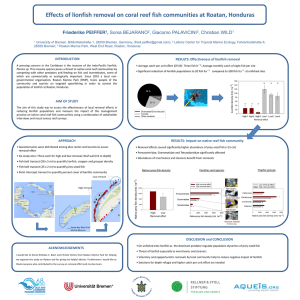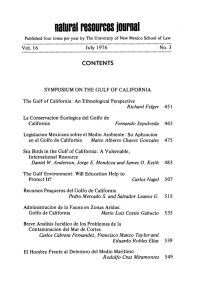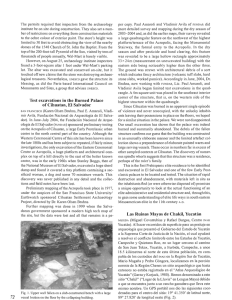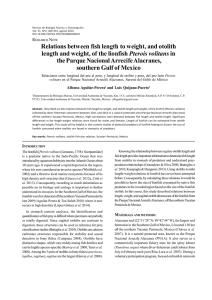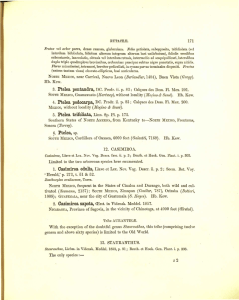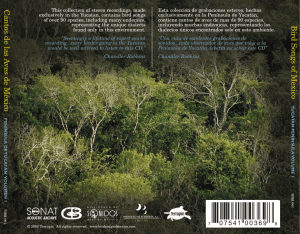corrected proof
Anuncio
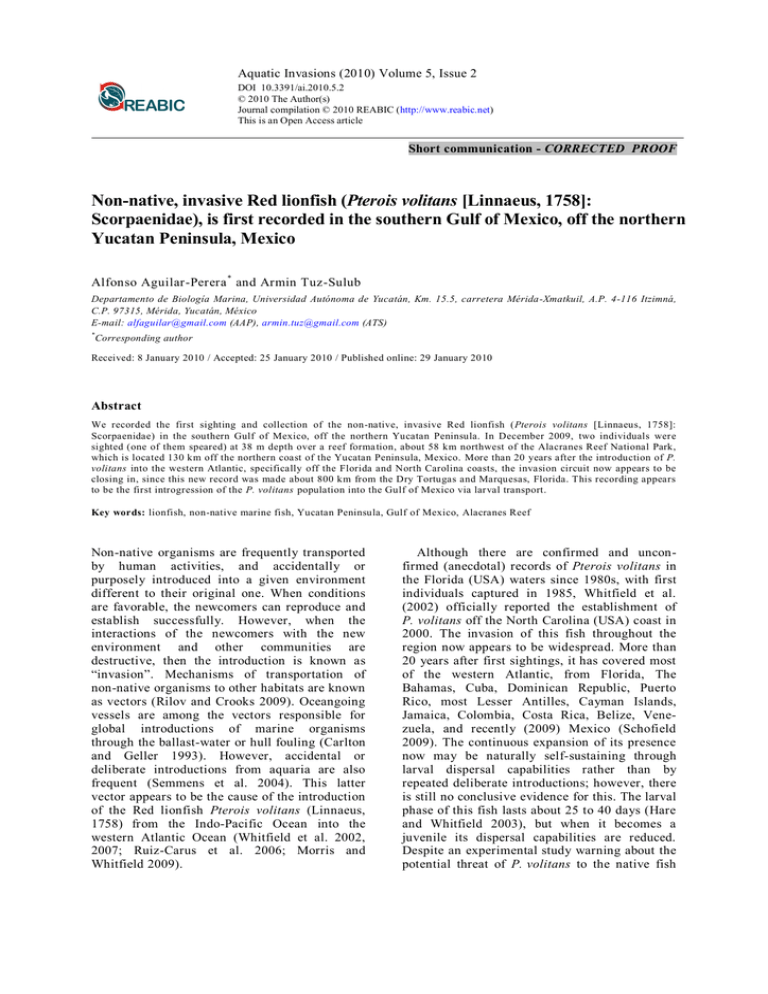
Aquatic Invasions (2010) Volume 5, Issue 2 DOI 10.3391/ai.2010.5.2 © 2010 The Author(s) Journal compilation © 2010 REABIC (http://www.reabic.net) This is an Open Access article Short communication - CORRECTED PROOF Non-native, invasive Red lionfish (Pterois volitans [Linnaeus, 1758]: Scorpaenidae), is first recorded in the southern Gulf of Mexico, off the northern Yucatan Peninsula, Mexico Alfonso Aguilar-Perera * and Armin Tuz-Sulub Departamento de Biología Marina, Universidad Autónoma de Yucatán, Km. 15.5, carretera Mérida-Xmatkuil, A.P. 4-116 Itzimná, C.P. 97315, Mérida, Yucatán, México E-mail: [email protected] (AAP), [email protected] (ATS) * Corresponding author Received: 8 January 2010 / Accepted: 25 January 2010 / Published online: 29 January 2010 Abstract We recorded the first sighting and collection of the non-native, invasive Red lionfish (Pterois volitans [Linnaeus, 1758]: Scorpaenidae) in the southern Gulf of Mexico, off the northern Yucatan Peninsula. In December 2009, two individuals were sighted (one of them speared) at 38 m depth over a reef forma tion, about 58 km northwest of the Alacranes Reef National Park, which is located 130 km off the northern coast of the Yucatan Peninsula, Mexico. More than 20 years after the introduction of P. volitans into the western Atlantic, specifically off the Florida and North Carolina coasts, the invasion circuit now appears to be closing in, since this new record was made about 800 km from the Dry Tortugas and Marquesas, Florida. This recording appears to be the first introgression of the P. volitans population into the Gulf of Mexico via larval transport. Key words: lionfish, non-native marine fish, Yucatan Peninsula, Gulf of Mexico, Alacranes Reef Non-native organisms are frequently transported by human activities, and accidentally or purposely introduced into a given environment different to their original one. When conditions are favorable, the newcomers can reproduce and establish successfully. However, when the interactions of the newcomers with the new environment and other communities are destructive, then the introduction is known as “invasion”. Mechanisms of transportation of non-native organisms to other habitats are known as vectors (Rilov and Crooks 2009). Oceangoing vessels are among the vectors responsible for global introductions of marine organisms through the ballast-water or hull fouling (Carlton and Geller 1993). However, accidental or deliberate introductions from aquaria are also frequent (Semmens et al. 2004). This latter vector appears to be the cause of the introduction of the Red lionfish Pterois volitans (Linnaeus, 1758) from the Indo-Pacific Ocean into the western Atlantic Ocean (Whitfield et al. 2002, 2007; Ruiz-Carus et al. 2006; Morris and Whitfield 2009). Although there are confirmed and unconfirmed (anecdotal) records of Pterois volitans in the Florida (USA) waters since 1980s, with first individuals captured in 1985, Whitfield et al. (2002) officially reported the establishment of P. volitans off the North Carolina (USA) coast in 2000. The invasion of this fish throughout the region now appears to be widespread. More than 20 years after first sightings, it has covered most of the western Atlantic, from Florida, The Bahamas, Cuba, Dominican Republic, Puerto Rico, most Lesser Antilles, Cayman Islands, Jamaica, Colombia, Costa Rica, Belize, Venezuela, and recently (2009) Mexico (Schofield 2009). The continuous expansion of its presence now may be naturally self-sustaining through larval dispersal capabilities rather than by repeated deliberate introductions; however, there is still no conclusive evidence for this. The larval phase of this fish lasts about 25 to 40 days (Hare and Whitfield 2003), but when it becomes a juvenile its dispersal capabilities are reduced. Despite an experimental study warning about the potential threat of P. volitans to the native fish A. Aguilar-Perera and A. Tuz-Sulub communities (Albins and Hixon 2008), there is no known clear impact of the invasion under natural conditions. Likewise, there is no real scientific understanding about its natural enemies in a new habitat. However, some groupers (Mycteroperca tigris [Valenciennes in Cuvier and Valenciennes, 1833], Epinephelus striatus [Bloch, 1792]) in the Bahamas were able to feed on P. volitans (Maljković et al. 2008). During September 2009, we provided lionfish information pamphlets to a small group of local spear- fishers from Puerto Progreso, Yucatan, Mexico, with the aim of recommending them to report any sighting of P. volitans (the pamphlet included two pictures and contact information). On December 21th 2009 at 2:00 PM, two P. volitans were sighted by a local spear-fisher at a reef formation locally known as “Pacharela” at 38 m depth (22°28.132' N and 90°14.232'W, Figure 1), which is located 58 km northwest to the Alacranes Reef National Park. This Park is located 130 km off the northern Yucatan Peninsula, Mexico. One of the P. volitans was speared, while the other one could not be captured because it was hidden in a reef cave. The collected fish (137 mm in total length; Figure 2) was examined following the key meristic identification characteristics established by Schultz (1986) while the other one, according to the fisherman, was smaller than the collected fish. An inspection of the body cavity of the collected fish revealed an empty stomach and immature gonads. Compared to individuals from other geographic areas (Table 1), the fish from the “Pacharela” reef (Mexico) was relatively small. The specimen was deposited in the Fish Collection (CIR-UADY-1466) of the Universidad Autónoma de Yucatán, México. In the Mexican Caribbean, P. volitans was first sighted in early 2009, off Cozumel Island, Quintana Roo, Eastern Yucatan Peninsula. Subsequently, there has been a progressive collection of individuals in locations off the mainland Mexican coast, such as at Playa del Carmen, Akumal, Xel-Ha, and even in the Banco Chinchorro (30 km off the coast and close to Belize). As a measure of mitigation for the invasion, there is an emergent program for the collection of individuals under the management of the Commission of Natural Protected Areas (CONANP), Yucatan Peninsula Program, which is a federal government agency and also under the municipality (state government) of Playa del Carmen, Quintana Roo. More than 100 individuals (less than 15 mm TL) have been collected so far in this area and continue to be taken by local divers who own diving shops and by other volunteers (Samuel Bretón and Maricarmen García, pers. comm.). Figure 1. Location of the “Pacharela” reef (star) off the northern Yucatan Peninsula, Mexico, where the fishermen speared the first recorded Red lionfish, Pterois volitans, in the southern Gulf of Mexico. Black dot indicates the geographic location of St. Petersburg, Florida, where a lionfish was found dead in 2006 (Brown and Ruiz-Carus 2006). Figure 2. Red lionfish, Pterois volitans (137 mm TL), captured in the “Pacharela” reef off the northern Yucatan Peninsula, southern Gulf of Mexico. Photograph by Armin Tuz-Sulub. Red lionfish in the southern Gulf of Mexico Table 1. Meristic data for the Red lionfish, Pterois volitans, from the "Pacharela" reef in the southern Gulf of Mexico, compared to individuals from other geographic areas. Indo-Pacific Colombia Florida North Carolina Mexico (Pacharela) XIII-12 XIII-12 XIII-12 XIII-11 XIII-11 III-8 III-8 III-8 III-7 III-8 Size (TL, mm) 85-235 96-157 378 120 137 Depth Site (m) unknown 16 45 40 38 A B C D E Dorsal fins Anal fins Source TL = total length. A: Schultz 1986, B = González et al. 2009, C = Ruiz-Carus et al. 2006, D = Whitfield et al. 2002, E = This study For the Gulf of Mexico, there was a previous report of an individual found dead off the St. Petersburg coast, Florida (Brown and Ruiz-Carus 2006); however, this fish was known to be recently introduced and did not get the Gulf of Mexico through larval transport. The two sightings in the “Pacharela” reef, off the northern Yucatan Peninsula, appear to be the first documented records of P. volitans in the Gulf of Mexico that arrived through larval transport after more than 20 years of the invasion’s onset. The implication this latter recording may have is interesting, since it represents indirect evidence that the invasion has been following the prevalent marine currents in the area. The Yucatan current flows through the Yucatan channel into the Gulf of Mexico, and then it is part of the Loop current (Ochoa et al. 2001). It is possible that larvae of P. volitans have dispersed through the Caribbean current, then to the Yucatan Current passing through the Yucatan Channel and are transported by the Loop Current. Now, the circuit of the P. volitans invasion appears to be closing in, since the potential displacement of individuals from the southern Gulf of Mexico to the Florida coast, following the Loop Current, is imminent (there is about 800 km from the Alacranes Reef to the Dry Tortugas and Marquesas in Florida). However, this latter assertion is still only a hypothesis that still needs to be refuted using genetic marker studies. References Albins MA, Hixon MA (2008) Invasive Indo-Pacific lionfish (Pterois volitans) reduce recruitment of Atlantic coral reef fishes. Marine Ecology Progress Series 367: 233-238, doi:10.3354/meps07620 Brown J, Ruiz-Carus R (2006) First-known lionfish caught in Florida's Gulf Coast waters. Fish and Wildlife Research Institute. http://research.myfwc.com/features/view_article.asp? id=27520 (Accessed on January 19, 2010) Acknowledgements Carlton JT, Geller JB (1993) Ecological roulette: the global transport of nonindigenous marine organisms. Science 261: 78-82, doi:10.1126/science.261.5117.78 González J, Grijalba-Bendeck M, Acero PA, Betancur RR (2009) The invasive red lionfish, Pterois volitans, in the southwestern Caribbean Sea. Aquatic Invasions 4: 507510, doi:10.3391/ai.2009.4.3.12 Hare JA, Whitfield PE (2003) An integrated assessment of the introduction of lionfish (Pterois volitans/miles complex) to the Western Atlantic Ocean. NOAA Technical Memorandum NOS NCCOS. 21 pp Maljković A, van Leeuwen TE, Cove SN (2008) Predation on the invasive red lionfish, Pterois volitans (Pisces: Scorpaenidae), by native groupers in the Bahamas. Coral Reefs 27: 501, doi:10.1007/s00338-008-0372-9 Morris JA Jr, Whitfield PE (2009) Biology, Ecology, control and management of the invasive Indo-Pacific lionfish: An updated integrated assessment. NOAA Technical Memorandum NOS NCCOS 99, 57 pp Ochoa J, Sheinbaum H, Badan A, Candela J, Wilson D (2001) Geostrophy via potential vorticity inversion in the Yucatan Channel. Journal of Marine Research 59: 725747, doi:10.1357/002224001762674917 Rilov G, Crooks JA (2009) Biological invasions in marine ecosystems: ecological, management and geographic perspectives. Ecological Studies 204, Springer-Verlag, 641 pp Ruiz-Carus R, Matheson RE, Roberts DE, Whitfield PE (2006) The western Pacific red lionfish, Pterois volitans (Scorpaenidae), in Florida: evidence for reproduction and parasitism in the first exotic marine fish established in state waters. Biological Conservation 128: 384-390, We greatly acknowledge the generously help of fishers from the fishing vessel “Don Chelo II” (from de company “Pulpesmar SA de CV”), Captain Humberto Manzano “Cacalchén” and his team of fishers: “Caxita”, “Bimbo”, “Chac-chi”, “Moyo”, “Primo”, “Huaro”, and especially to the fisher “Cóli” who speared the lionfish and brought it to us. The map was originally drawn by Daniel Poot-Cardós with modifications. We also thank the anonymous reviewer´s suggestions and recommendations. Schofield PJ (2009) Geographic extent and chronology of the invasion of non-native lionfish (Pterois volitans [Linnaeus 1758] and P. miles [Bennett 1828]) in the Western North Atlantic and Caribbean Sea. Aquatic Invasions 4: 473-479, doi: 10.3391/ai.2009.4.3.5 Semmens, BX, Buhle ER, Salomon AK, Pattengill-Semmens CV (2004) A hotspot of non-native marine fishes: evidence for the aquarium trade as an invasion pathway. doi:10.1016/j.biocon.2005.10.012 A. Aguilar-Perera and A. Tuz-Sulub Marine Ecology Progress Series 266: 239-244, doi:10.3354/meps266239 Schultz ET (1986) Pterois volitans and Pterois miles: two valid species. Copeia 3: 686-690, doi:10.2307/1444950 Whitfield PE, Gardner T, Vives SP, Gilligan MR, Courtenay WR Jr, Ray GC, Hare JA (2002) Biological invasion of the Indo-Pacific lionfish (Pterois volitans) along the Atlantic coast of North America. Marine Ecology Progress Series 235: 289-297, doi:10.3354/meps235289 Whitfield PE, Hare JA, David AW, Harter SL, Munoz RC, Addison CM (2007) Abundance estimates of the Indopacific lionfish Pterois volitans/miles complex in the western North Atlantic. Biological Invasions 9: 53-64, doi:10.1007/s10530-006-9005-9

